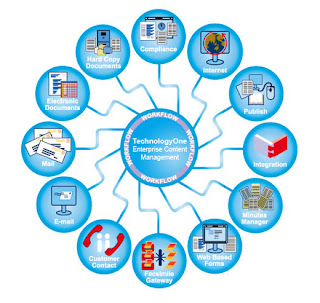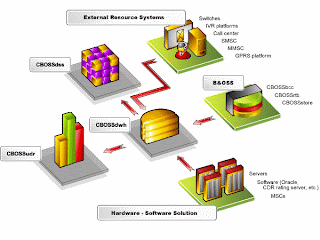Decision Support Systems (DSS) are a class of computerized information system that support decision-making activities. DSS are interactive computer-based systems and subsystems intended to help decision makers use communications technologies, data, documents, knowledge and/or models to complete decision process tasks.
A decision support system may present information graphically and may include an expert system or artificial intelligence (AI). It may be aimed at business executives or some other group of knowledge workers.
Typical information that a decision support application might gather and present would be, (a) Accessing all information assets, including legacy and relational data sources; (b) Comparative data figures; (c) Projected figures based on new data or assumptions; (d) Consequences of different decision alternatives, given past experience in a specific context.
There are a number of Decision Support Systems. These can be categorized into five types:
From: http://www.mis.cmich.edu/bis644/dss_01/sld001.htm
A decision support system may present information graphically and may include an expert system or artificial intelligence (AI). It may be aimed at business executives or some other group of knowledge workers.
Typical information that a decision support application might gather and present would be, (a) Accessing all information assets, including legacy and relational data sources; (b) Comparative data figures; (c) Projected figures based on new data or assumptions; (d) Consequences of different decision alternatives, given past experience in a specific context.
There are a number of Decision Support Systems. These can be categorized into five types:
- Communication-driven DSS Most communications-driven DSSs are targetted at internal teams, including partners. Its purpose are to help conduct a meeting, or for users to collaborate. The most common technology used to deploy the DSS is a web or client server. Examples: chats and instant messaging softwares, online collaboration and net-meeting systems.
- Data-driven DSS Most data-driven DSSs are targeted at managers, staff and also product/service suppliers. It is used to query a database or data warehouse to seek specific answers for specific purposes. It is deployed via a main frame system, client/server link, or via the web. Examples: computer-based databases that have a query system to check (including the incorporation of data to add value to existing databases.
- Document-driven DSS Document-driven DSSs are more common, targeted at a broad base of user groups. The purpose of such a DSS is to search web pages and find documents on a specific set of keywords or search terms. The usual technology used to set up such DSSs are via the web or a client/server system.
- Knowledge-driven DSS
Knowledge-driven DSSs or 'knowledgebase' are they are known, are a catch-all category covering a broad range of systems covering users within the organization seting it up, but may also include others interacting with the organization - for example, consumers of a business. It is essentially used to provide management advice or to choose products/services. The typical deployment technology used to set up such systems could be slient/server systems, the web, or software runnung on stand-alone PCs.
- Model-driven DSS Model-driven DSSs are complex systems that help analyse decisions or choose between different options. These are used by managers and staff members of a business, or people who interact with the organization, for a number of purposes depending on how the model is set up - scheduling, decision analyses etc. These DSSs can be deployed via software/hardware in stand-alone PCs, client/server systems, or the web.
From: http://www.mis.cmich.edu/bis644/dss_01/sld001.htm
Transaction Processing System
Transaction processing

- supported by programs that are called transaction processing systems.
- provide three functional areas:
- 1.System runtime functions
- Transaction processing systems provide an execution environment that ensures the integrity, availability, and security of data. It also ensures fast response time and high transaction throughput.
- 2.System administration functions
- Transaction processing systems provide administrative support that lets users configure, monitor, and manage their transaction systems.
- 3.Application development functions
- Transaction processing systems provide functions for use in custom business applications, including functions to access data, to perform intercomputer communications, and to design and manage the user interface.

The advantages of TPS
We have now seen the reasons why we need transaction processing systems. The advantages of three-tier applications in creating scalable and robust applications are made feasible by transaction processing systems. The ability to distribute the components that make up applications amongst separate servers without explicitly having to develop for that architecture is another advantage of transaction server processing. Transaction processing systems also ensure that transactions are atomic, consistent, isolated, and durable. This alleviates the developer from having to support these characteristics explicitly.
With all of these excellent reasons for developing an application that uses atransaction processing system, we now need a system that provides these features. We will now turn our attention to a transaction processing system that is part of the standard IIS 4.0 installation: Microsoft Transaction Server.
With all of these excellent reasons for developing an application that uses atransaction processing system, we now need a system that provides these features. We will now turn our attention to a transaction processing system that is part of the standard IIS 4.0 installation: Microsoft Transaction Server.
From:http://www.auditmypc.com/acronym/tps.asp
Office Automation System & Knowledge Work System
Knowledge work systems and office automation systems serve the information needs at the knowledge level of the organization. , where as office automation systems primary aid data workers (although they are also used extensively by knowledge workers)
Office Automation Systems

http://www.erdc.usace.army.mil/pls/erdcpub/www_welcome.navigation_page?tmp_next_page=39811
Read more:http://wiki.answers.com/Q/What_is_an_office_automation_system_and_a_knowledge_work_system#ixzz1GfDV6dDh
Office Automation Systems
http://www.erdc.usace.army.mil/pls/erdcpub/www_welcome.navigation_page?tmp_next_page=39811
Read more:http://wiki.answers.com/Q/What_is_an_office_automation_system_and_a_knowledge_work_system#ixzz1GfDV6dDh
Information Flow in Organisation
An information flow diagram (IFD) is an illustration of information flowthroughout an organisation. An IFD shows the relationship between external and internal information flows between an organisation. It also shows the relationship between the internal departments and sub-systems.

An Information Flow Diagram is information about a system laid out in diagramatic form. Usually using "blobs" to explain in more details the system and sub-systems to elemental parts. Following on from this you can add in lines of how the information travels from one system to another. This is used in businesses, Government agencies, television and cinematic processes.
An Information Flow Diagram is information about a system laid out in diagramatic form. Usually using "blobs" to explain in more details the system and sub-systems to elemental parts. Following on from this you can add in lines of how the information travels from one system to another. This is used in businesses, Government agencies, television and cinematic processes.
Monday, March 14, 2011
Functions of An Organization
An information system is a collection of people, procedures, software, hardware and data. All of them are combined together to provide information essential to running an organization. Computerized information systems nowaday had already support the vertical and horizontal flow of information within the organization. There are several different basic funtional areas in a organization. Most organizations have departments that specialize in one of five basic functions. These 5 basic functions are Accounting, Marketing, Human resourse, Production and Research.
Accounting: records all financial activity from billing customers to paying employees. It also produces the financial condition report of company.
Accounting: records all financial activity from billing customers to paying employees. It also produces the financial condition report of company.
Marketing: plans, prices, promotes and sells the organization's goods and services.
Human Resourse: relates to people in each of the functional areas. It focuses on people that including hiring. training, promoting and any number of other human-centered activities in the organization.
Production: produces goods and services.
Research: identifies, investigates and develops new goods and services.
Human Resourse: relates to people in each of the functional areas. It focuses on people that including hiring. training, promoting and any number of other human-centered activities in the organization.
Production: produces goods and services.
Research: identifies, investigates and develops new goods and services.

No comments:
Post a Comment